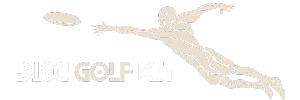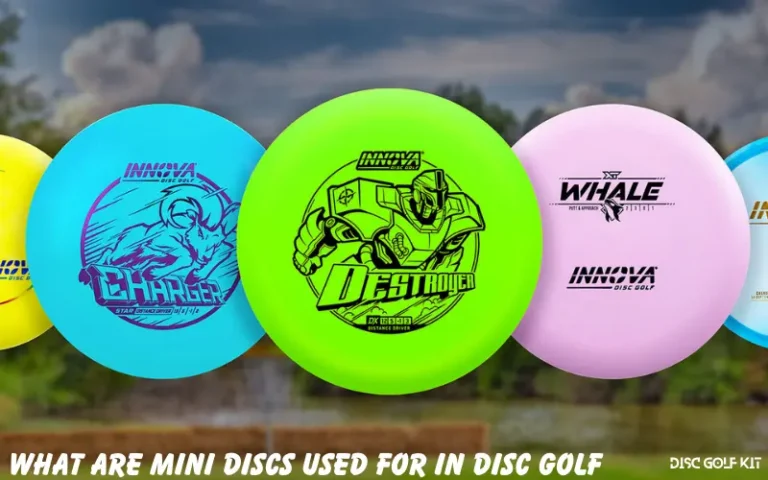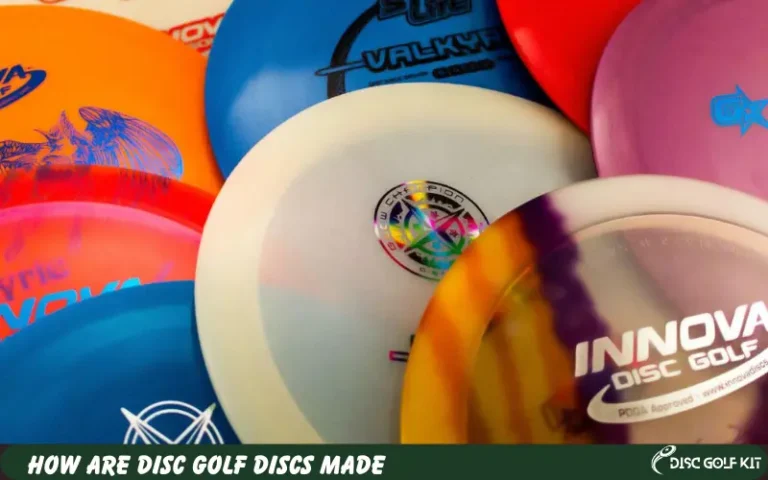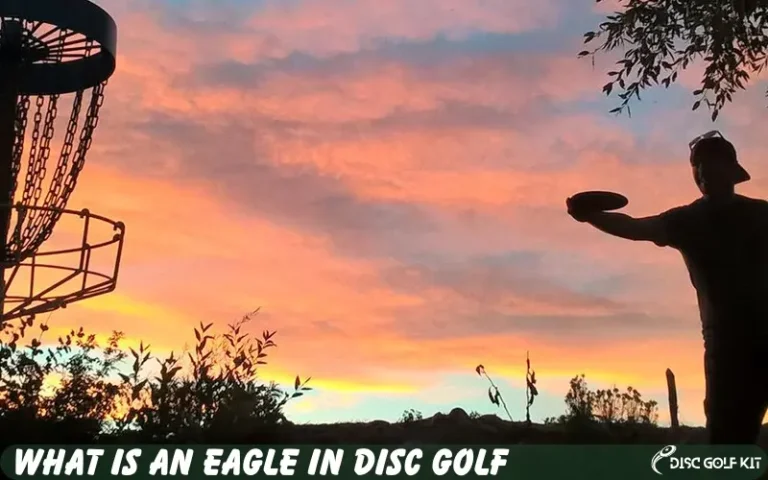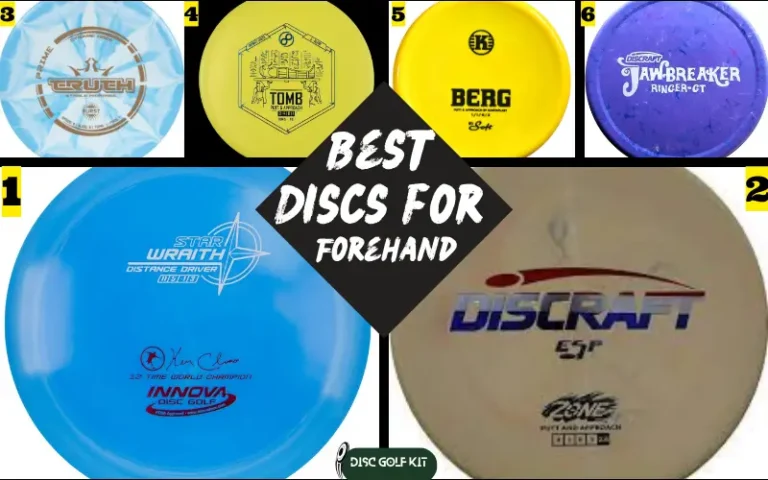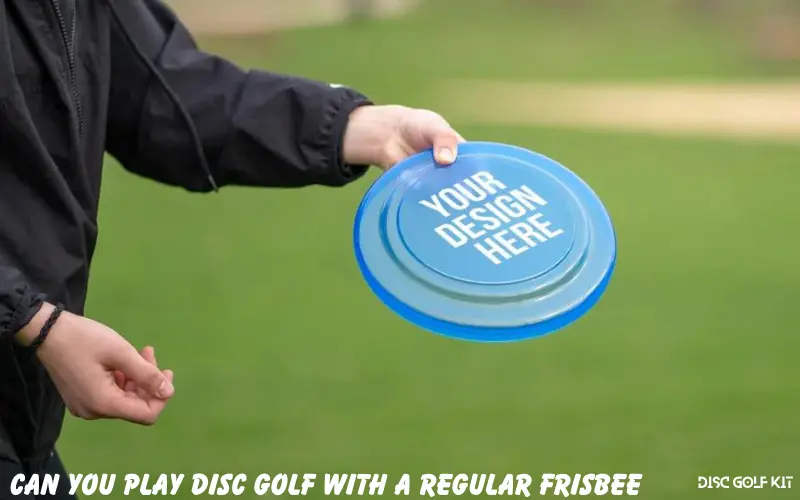
Disc golf is a rapidly growing sport that combines the precision and rules of traditional golf with the fun and accessibility of Frisbee throwing. Players aim to complete a course in the fewest number of throws, launching their discs from a tee area to an elevated metal basket. Just like traditional golf, understanding the terminology can be pivotal in enhancing your gameplay and your overall enjoyment of the sport.
It’s not just about throwing a disc; it’s about knowing what kind of throw you’re executing, what type of disc is optimal, and how to navigate the course. One burning question many beginners have is, “Can you play disc golf with a regular Frisbee?” If this question has been nagging you, keep reading. This article is your one-stop guide to understanding disc golf terms and settling the debate about using a regular Frisbee in a game of disc golf.
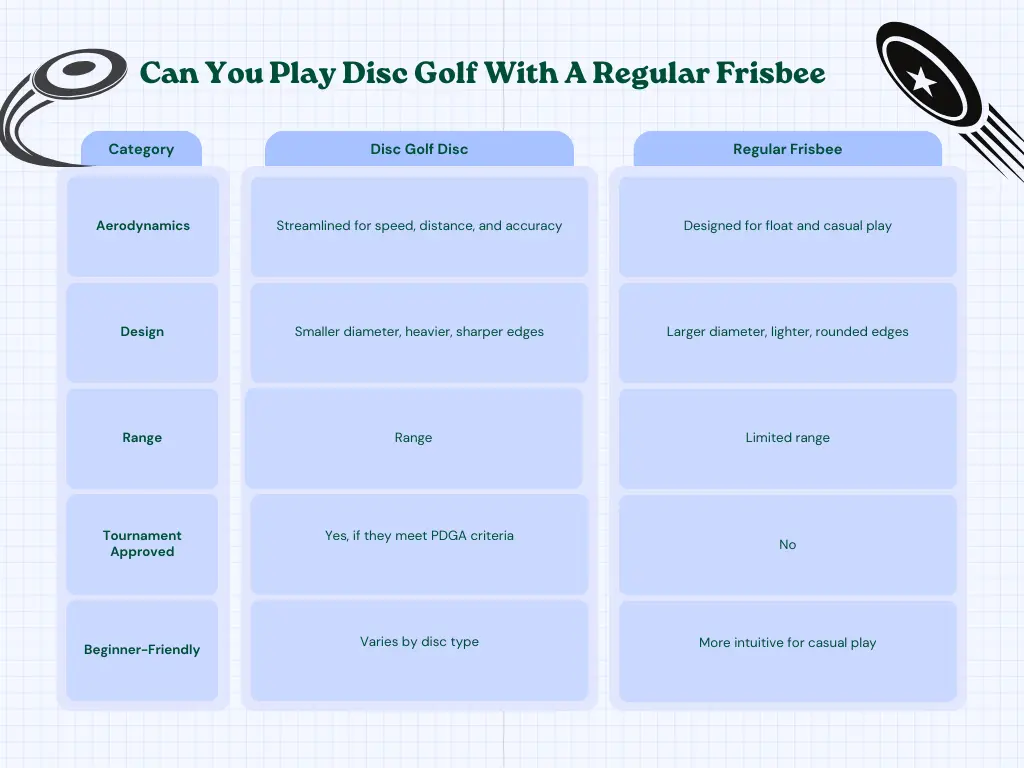
Can You Play Disc Golf With a Regular Frisbee?
After journeying through the labyrinth of disc golf terminology, specialty shots, and types of discs, we arrive at the cornerstone query: Can you play disc golf with a regular Frisbee? The answer is yes, But let’s dissect this question by looking at the physics involved, the pros and cons, and ultimately reach a conclusion.
The Physics of a Disc Golf Disc vs a Regular Frisbee
A disc golf disc and a regular Frisbee are fundamentally different in their design and aerodynamics. Disc golf discs are generally smaller in diameter, heavier, and have a more streamlined edge. This design allows them to cut through the air more efficiently, offering greater speed, distance, and accuracy. A regular Frisbee, with its larger diameter and rounded edges, is designed for casual play and floats in the air, making it less predictable and less capable of covering long distances or navigating around obstacles.
The Pros of Using a Regular Frisbee
The Cons of Using a Regular Frisbee
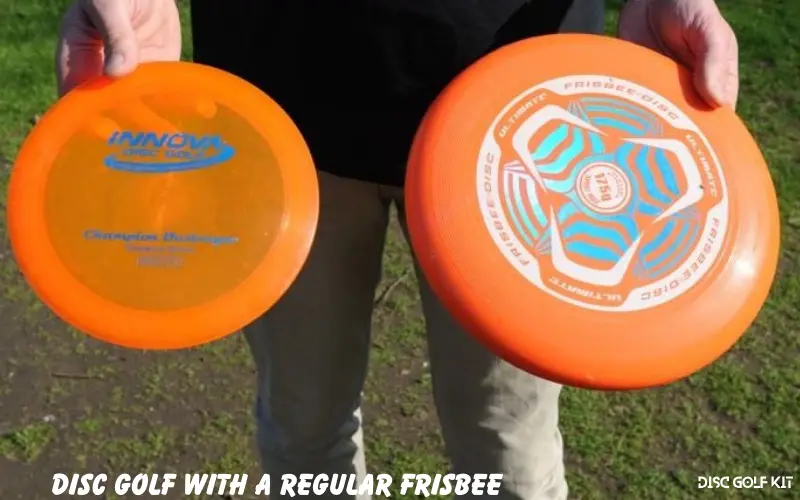
Basic Disc Golf Terms
Navigating a disc golf course can feel like stepping into a new world, especially if you’re not familiar with the terminology. To help you feel right at home on the course, let’s break down some of the most basic disc golf terms.
Tee
The “Tee” or “Tee Box” is the designated starting area for each hole on a disc golf course. This is where you make your initial throw, also known as a “drive,” aiming to cover as much distance as possible toward the Basket. Understanding the dimensions and layout of the Tee can help you strategize your initial throw for the best possible outcome.
Basket
The “Basket” or “Target” is what you’re aiming for in disc golf. Officially known as a “Disc Pole Hole,” it’s an elevated metal basket with chains hanging above it. The objective is to get your disc to land in this Basket in as few throws as possible. Sinking the disc into the Basket completes the hole, and you move on to the next Tee.
Fairway
The “Fairway” is the playing area that stretches between the Tee and the Basket. It can be compared to the fairway in traditional golf, serving as the pathway your disc ideally follows as you progress toward the Basket. Fairways can be open or filled with obstacles like trees, water hazards, and varying terrain, which add a layer of complexity to the game.
Intermediate Disc Golf Terms
As you gain more experience on the disc golf course, you’ll start to encounter terms that go beyond the basics. These are essential for players looking to refine their skills and understand the game on a deeper level.
Anhyzer and Hyzer
The terms “Anhyzer” and “Hyzer” refer to the angle at which you release the disc relative to your body and the ground. A Hyzer throw is released with the outer edge of the disc tilted downward, causing the disc to curve to the left for right-handed players and to the right for left-handed players. An Anhyzer throw is the opposite; you release the disc with the outer edge tilted upward, resulting in a curve to the right for right-handed players and the left for left-handed players.
Birdie and Bogey
Much like in traditional golf, disc golf also has terms for scoring relative to the par of a hole. A “Birdie” means that you’ve completed the hole in one throw fewer than the set par, a significant accomplishment. A “Bogey,” on the other hand, signifies that it took you one throw more than the par to complete the hole, indicating room for improvement.
Forehand and Backhand
Forehand and Backhand refer to the two primary throwing techniques in disc golf. A “Backhand” throw is similar to the traditional Frisbee throw, where you hold the disc with your thumb on top and fingers underneath, swinging your arm across your body to release. The “Forehand” throw, often called a flick, involves holding the disc with your thumb on top and your index finger along the bottom edge, then flicking the wrist to release the disc.

Advanced Disc Golf Terms
For players who have already gotten their feet wet and are looking to dive deeper into the intricacies of disc golf, there are a host of advanced terms to get familiar with. These terms will help you understand the complexities of the game and fine-tune your strategies.
Roller
A “Roller” is a specialized shot that, as the name suggests, rolls along the ground rather than flying through the air for the majority of its distance. To execute a roller, the disc is thrown at an angle that allows it to hit the ground and roll toward the Basket. This technique is particularly useful for navigating tight spaces or low ceilings where a traditional throw might not be effective.
Island Hole
An “Island Hole” refers to a hole where the Basket is situated on a specific area of land, usually surrounded by out-of-bounds zones. Players must land their disc within this ‘island’ without going out-of-bounds to complete the hole. Island holes can be quite challenging and require precise throwing skills.
Mando
Short for “Mandatory,” a “Mando” is a rule imposed on specific holes where the disc must pass to the left or right of a particular obstacle, like a tree or a pole. If a player fails to navigate the disc according to the Mando rule, they usually incur a penalty stroke and must throw again from a designated area.
Specialty Shots and Discs
As you progress in your disc golf journey, you’ll find that the game is as much about skill as it is about strategy. Knowing when to use a particular shot or disc can be the difference between a Birdie and a Bogey. Here, we’ll delve into some specialty shots and the types of discs commonly used in the game.
Tomahawk and Thumber
Both the “Tomahawk” and “Thumber” shots are overhand throws that involve flipping the disc vertically before release. The main difference lies in the grip and the resulting flight pattern. In a Tomahawk throw, the disc is held in a forehand grip and spins clockwise, resulting in a left-to-right flight pattern for right-handed players. The Thumber uses a backhand grip, spinning the disc counter-clockwise, which produces a right-to-left flight pattern for right-handed players. These shots are useful for overcoming obstacles or taking shortcuts over trees.
Putters vs Drivers
Just as traditional golf has different clubs for different situations, disc golf has a variety of discs designed for specific throws. “Putters” are designed for short, accurate throws, typically used for sinking the disc into the Basket. They are slower and easier to control but won’t cover a lot of distance. “Drivers,” on the other hand, are built for speed and distance. They are usually the choice for the initial throw from the Tee. Drivers are harder to control but can cover a large distance quickly, making them ideal for open fairways.
Conclusion
We’ve embarked on an enlightening journey through the diverse and intricate world of disc golf, exploring the terminology from basic to advanced and discussing specialty shots and types of discs. Each term and concept plays an integral role in shaping your experience on the course, influencing your performance and, ultimately, your enjoyment of this exciting sport.
As for the central question that guided our exploration—Can You Play Disc Golf With A Regular Frisbee?—the answer is nuanced. While a regular Frisbee can provide an introduction to the game, it lacks the specialized design features that enable the precision, distance, and control that dedicated disc golf discs offer. For casual or beginner-level play, a regular Frisbee might suffice, but for anyone committed to improving their skills, specialized discs are the way to go.
So, what are you waiting for? Now that you’re equipped with all this valuable information, it’s time to step out onto the course and experience the thrill of disc golf for yourself. Whether you start with a regular Frisbee or go straight for the specialized discs, the fairway awaits!
Frequently Asked Questions (FAQs)

Written by
Declan Hodgson
Meet Declan Hodgson, your disc golf sherpa at DiscGolfKit.com. Navigating the twists and turns of the sport, I’m here to guide you through the world of discs, gear, and the pursuit of that perfect throw.
